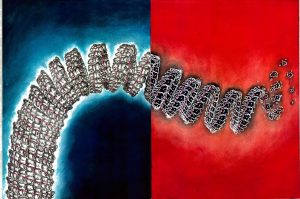From the Journal: The Journal of Chemical Physics
WASHINGTON, October 20, 2020 — The Ebola virus causes a serious infection with a mortality rate between 50% and 90%. Nucleoproteins in the virus assemble into a helical arrangement and encapsulate a single stranded RNA genome, ssRNA, to form a rodlike complex known as a nucleocapsid, which is critical to the function of the virus. Rodlike nucleocapsids are also found in other viruses, like SARS-CoV-2, which causes COVID-19.

In The Journal of Chemical Physics, by AIP Publishing, scientists at the University of Delaware report a computational study of this nucleocapsid and show that the binding of the ssRNA allows the nucleocapsid to maintain its shape and structural integrity.
Simulations of viruses are difficult because the systems are very large. Only a few capsids, including hepatitis B, HPV, HIV-1, and the satellite tobacco mosaic virus, have been investigated at the atomic level. Molecular dynamics simulations of the Ebola nucleocapsid, to date, have been conducted only of its isolated constituents and not at the atomic level.
This work represents the first atomic-level computational investigation of the Ebola nucleocapsid assembly. The model used by the investigators included all atoms in the helical nucleoprotein assembly, the ssRNA, water molecules, and even ions, such as sodium and chloride, that stabilize this highly charged structure.
The resulting model has 4.8 million atoms, namely the nucleocapsid structure with the ssRNA present and without it. The second system was included as a control to investigate the role of the ssRNA.
“We found that ssRNA encapsidation results in stabilization of the Ebola virus nucleocapsid and is essential for maintaining structural integrity of its helical assembly,” said author Juan Perilla.
The investigators found that the nucleoprotein interactions and ions contribute to the stability of the nucleocapsid. In the Ebola nucleocapsid, nucleoproteins connect with each other to form a helical assembly. Sodium and chloride ions were found to cluster near the nucleocapsid in the simulation to counter its charge repulsions.
The rodlike nucleocapsid structure is essential for the Ebola virus’s ability to infect and evade cellular defense mechanisms as well as its ability to replicate within host cells. The nucleocapsid acts as a scaffold for virus assembly and as a template for transcription of the virus’s genes and replication. Its critical roles during infection make it an ideal candidate for antiviral intervention.
Molecular-level knowledge of virus dynamics is needed to understand structure and function and pinpoint vulnerabilities, but it is usually inaccessible from experiment. These insights are readily available from computer simulations, however.
This study should help scientists develop drug treatments that target viral nucleocapsids. The investigators anticipate the methodological approach they have developed for Ebola can be used to study other helical structures, such as the nucleocapsid of SARS-CoV-2.
###
For more information:
Larry Frum
media@aip.org
301-209-3090
Article Title
Molecular determinants of Ebola nucleocapsid stability from molecular dynamics simulations
Authors
Chaoyi Xu, Nidhi Katyal, Tanya Nesterova, and Juan R. Perilla
